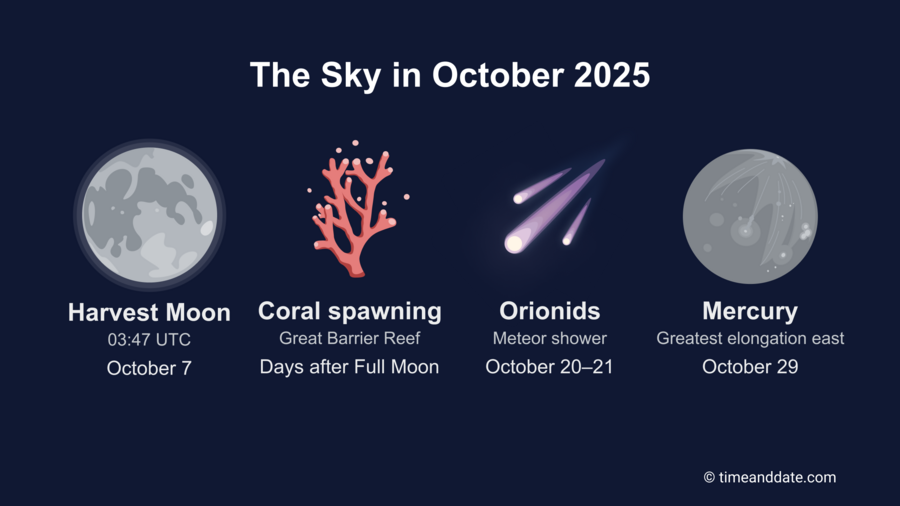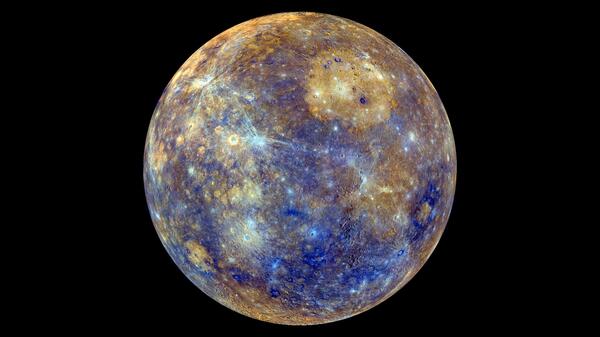
What’s Up in the Sky in October?
| Date | Event* | What to See |
|---|---|---|
| Oct 5–6 | Moon-Saturn conjunction | The almost Full Moon meets up with Saturn. |
| Oct 7 | Full Moon | October’s Harvest Moon is at its most illuminated at 03:47 UTC. |
| Oct 8–9 | Draconid meteor shower | Up to 5 meteors per hour, but can be dimmed by a bright almost Full Moon. |
| Oct 14 | Moon-Jupiter conjunction | The Moon finds Jupiter around Third Quarter. |
| Oct 19 | Moon-Venus conjunction | A wafer-thin Waning Crescent Moon finds Venus. |
| Oct 20–21 | Orionid meteor shower | Up to 20 meteors per hour and perfect dark skies around New Moon. |
| Oct 29 | Mercury greatest elongation | Mercury shines bright at greatest elongation east. |
*Naked-eye events. Night Sky Map links are from New York City, USA.
October Harvest Moon
This year, the Harvest Moon lands on October 7, 2025. It is defined as the closest Full Moon to autumnal (fall) equinox in the Northern Hemisphere.
As well as being named after the harvest season in the northern half of the globe, the moonrise times around Full Moon at the autumnal equinox are favorable to getting in the harvest. This is because the difference in the time between moonrise from one night to the next becomes less than the average of 50 minutes. The result is that, for several nights in a row, there’s extra moonlight in the evenings. Historically, this gave farmers more time to harvest crops.
The opposite takes effect in the Southern Hemisphere around the September equinox with more than 50 minutes between moonrise from one day to the next around the Full Moon.
Two Meteor Showers in October
Meteors, or shooting stars, are the bright streaks of light that occur when a meteoroid—a rock in space—hits our atmosphere and burns up. Meteor showers occur when Earth passes through a trail of debris left by a comet or asteroid.
October boasts two meteor showers: the Draconid meteor shower peaking around October 8–9, and the Orionid meteor shower peaking around October 20–21. The bad news is that the glare from the bright Full Moon will reduce the number of Draconids that are visible this year. The good news is that the Orionids peak close to New Moon, when the night sky is at its darkest.
The origin of the Draconids is the dust trail left by comet 21P/Giacobini-Zinner. Meanwhile, the Orionids have a more famous parent body: Halley’s Comet. Have a look at our tips for watching meteor showers.
Meteor shower calendar 2025/26

Coral Spawning Follows October Full Moon
In the days after Full Moon in October and November, corals in Australia’s Great Barrier Reef simultaneously release bundles of eggs and sperm into the sea. This phenomenon is called coral spawning.
The event only happens at night, and its timing hinges on a number of factors including Moon phase, water temperatures, salinity levels, and the length of day.
In the case of the Great Barrier Reef, the inshore reefs usually spawn in October; the outer reefs tend to spawn during November or December. Meanwhile at the Flower Garden Banks National Marine Sanctuary, off the coast of Texas and Louisiana in the USA, coral spawning typically happens after the August Full Moon.

Mercury Makes a Bright Appearance
Mercury shines bright on October 29 as it reaches its greatest elongation east. In general, the days on either side of greatest elongations are the best time to catch the innermost planet in our solar system.
Because Mercury is small and lies close to the Sun, it can be a challenge to observe. But at greatest elongation east, there is a chance to see it with the naked eye soon after sunset.
And the elusive Mercury tends to favor one or other of the hemispheres—this time stargazers in the Southern Hemisphere get the best view.
Whichever part of the globe you look from, Mercury and the Sun will be the same distance apart in the sky. But their alignment looks different from the Northern and Southern Hemispheres.
Because of the way the Earth is tilted, greatest eastern elongations look best around the spring equinox—Mercury appears higher above the horizon after sunset.
The Southern Hemisphere had its spring equinox in September, so it gets the best view of this greatest elongation at the end of October.
Graham Jones, Astrophysicist
mungfali.galihkartiwa07.workers.devThere will be a close approach of Mercury and Mars on October 20, seen here from Sydney, Australia, as the two planets set.
And on October 23, the Waxing Crescent Moon will join Mercury and Mars—as seen here in Sydney at around 20:15 (8:15 pm) local time.
But beware: Do not try to observe objects close to the Sun while any part of the Sun is above the horizon. Never point binoculars or a telescope in the direction of the Sun—it can cause permanent eye damage.
Frequently Asked Questions
Which planets are in the night sky tonight?
Our Interactive Night Sky Map gives the rise and set times for the planets in your town or city.
How many planets are there?
According to the latest definition, there are 8 planets in our solar system.
How long does it take to get to Venus?
A typical journey time is around four or five months.
